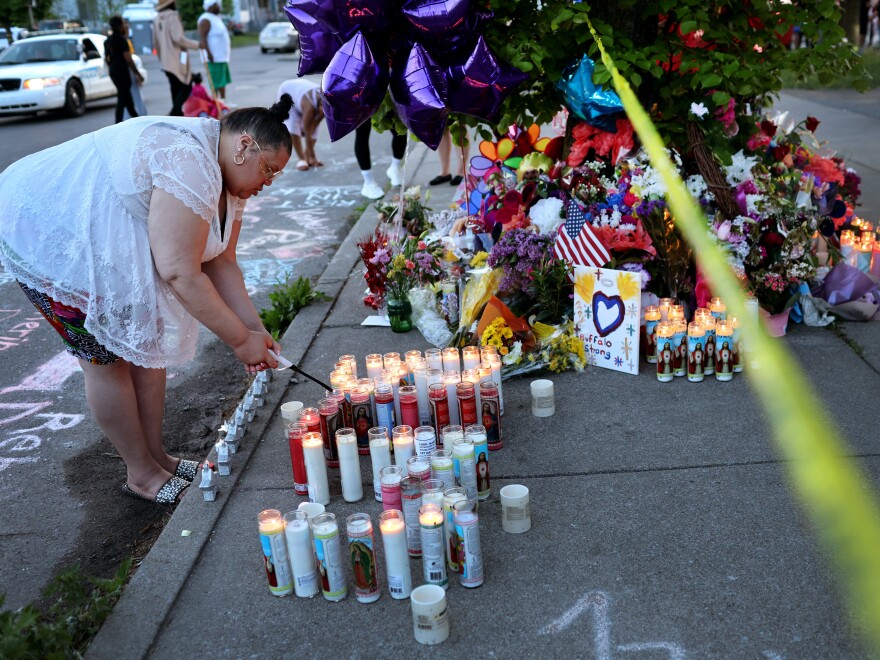Racism and segregation are two of the major factors which led to the tragedy of the Tops shooting on May 14 on Buffalo’s East Side.
Despite the shooter hailing from outside of Western New York — he was able to carry out his racist attack specifically because he knew where the majority of African Americans were located in the city.
But the killer’s white supremacist ideology, is not only found below the Mason-Dixon Line, as former Legal Aid Bureau of Buffalo Staff Attorney Miles Gresham said in "Buffalo, What’s Next?" segment in June of 2022.
“If you'll recall,” he said, "the day after the shooting, there was racist graffiti sprayed on a family's fence in in Niagara Falls. They regularly have white supremacist running for office in the northtowns. So, no, I don't think it matters. systemic racism like we were talking about didn't pick up a gun and kill people. But that philosophy, that deep-seated racism and hatred is all around this area.”
Racism is part in parcel when it comes to neighborhood segregation.
The City of Buffalo and Western New York has a long history of segregation and segregation is a topic that was covered extensively on "Buffalo, What’s Next?"
Thirty-seven percent of residents in the City of Buffalo are African American and out of that percentage, 85% live in neighborhoods east of Main Street.
Government enforced zoning laws, Housing covenants and other racist practices from past generations created what we call redlining.
Henry Louis Taylor, Jr. is the urban studies director for the University at Buffalo and author of "The Harder We Run: The State of Black Buffalo from 1990 to the Present."

He argues race-based residential segregation has led the City of Buffalo to where it is today.
“We like to think about racial residential segregation as some kind of legacy of the past,” he said. “But it's not and it's not just driven by, ‘White people don't like black people.’”
Taylor said problem goes beyond White Flight.
“It’s tied up with profits,” he said. “It’s tied up with wealth production. It's tied up in the very way in which we design and construct our neighborhoods.”
Taylor explained further.
“The development of neighborhoods — whiteness and social class exclusivity was embedded in the way in which value was created,” he said. “The very concept of value as it related to housing and residential areas was based upon race whiteness. So, within that formula as a community becomes increasingly white, and as social class exclusivity grows, value goes up.”
By that same token, as the proportion of African Americans into a neighborhood increases along with social class inclusivity, value goes down.
It’s in this vein, Taylor said that we design neighborhoods around housing value and for many working class and working poor African Americans in Buffalo, they are essentially contained in these east side neighborhoods.
“They've literally built a high rent wall around the African American community," he said. “So, blacks are segregated on the lowest valued land in all of Erie County. But the rent structure; how much you pay for rent, keeps them contained, fit, fixed and stuck in that space.”
St. Luke’s Mission of Mercy Board of Directors Vice President Sydnie Perkins grew up on Buffalo’s east side and said generational disinvestment and lack of community building has left parts of the east side with the stigma of being inhospitable to white people.
“It’s like a band aid affect,” she said. “People will come to the east side. You're uncomfortable. They swing by just for the Dyngus Day or just to go to the Broadway Market for the Easter celebration and they feel like what they're doing is enough, but the lack of engagement, the lack of coming together and community building is the disservice that is being done.”
It’s the concept of suburban and rural white people avoiding the east side of Main Street, Gresham said.
A concept further actualized by segregation.
“So, no, redlining and segregation did not physically pick up a gun and shoot people,” he said following the Tops shooting. “But, certainly that segregation contributed to that idea of otherizing that the shooter internalized.”

Are there ways, right now, to dismantle this legacy of disenfranchisement?
Gresham said more funding, both public and private, needs to go to the people who have been historically discriminated against.
“We can be unequivocal about the remnants of redlining that still exist in private banks today,” he said. “We can make sure that there are more opportunities for affordable housing not just in the city of Buffalo but also in the county where affordable housing numbers are quite abysmal.”
In terms of furthering east side development, Taylor said the essential question is ‘who controls the land?’
Publicly financed land trusts provide residents a voice in the development of their community.
“The city should give over say all of its publicly owned vacant lots to such an entity then the community would have control over the forms and types of development that occurs,” he said.
“You divide the neighborhoods into planning areas where the people who live in a neighborhood and the communities work closely with those planners to determine how to grow and develop those neighborhoods and the communities.”
And make improving substandard housing central to that development.
“Fix the houses where people currently live,” Taylor said.
But Taylor doubts the city would ever go this route of giving up the vacant lots because there is money in selling that low value land to private development companies.
Racism and segregation have played a role in the history of Buffalo’s development, culminating in the tragedy of May 14, but by no means do these factors need to play a role in the city’s future.





